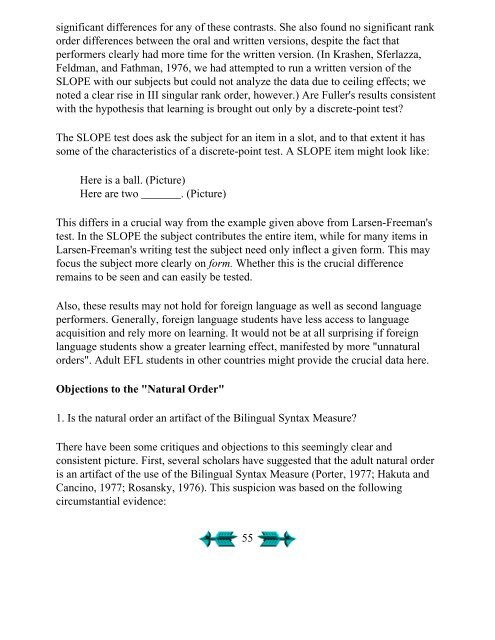Second Language Acquisition and Second ... - Stephen Krashen
Second Language Acquisition and Second ... - Stephen Krashen
Second Language Acquisition and Second ... - Stephen Krashen
Create successful ePaper yourself
Turn your PDF publications into a flip-book with our unique Google optimized e-Paper software.
significant differences for any of these contrasts. She also found no significant rank<br />
order differences between the oral <strong>and</strong> written versions, despite the fact that<br />
performers clearly had more time for the written version. (In <strong>Krashen</strong>, Sferlazza,<br />
Feldman, <strong>and</strong> Fathman, 1976, we had attempted to run a written version of the<br />
SLOPE with our subjects but could not analyze the data due to ceiling effects; we<br />
noted a clear rise in III singular rank order, however.) Are Fuller's results consistent<br />
with the hypothesis that learning is brought out only by a discrete-point test?<br />
The SLOPE test does ask the subject for an item in a slot, <strong>and</strong> to that extent it has<br />
some of the characteristics of a discrete-point test. A SLOPE item might look like:<br />
Here is a ball. (Picture)<br />
Here are two _______. (Picture)<br />
This differs in a crucial way from the example given above from Larsen-Freeman's<br />
test. In the SLOPE the subject contributes the entire item, while for many items in<br />
Larsen-Freeman's writing test the subject need only inflect a given form. This may<br />
focus the subject more clearly on form. Whether this is the crucial difference<br />
remains to be seen <strong>and</strong> can easily be tested.<br />
Also, these results may not hold for foreign language as well as second language<br />
performers. Generally, foreign language students have less access to language<br />
acquisition <strong>and</strong> rely more on learning. It would not be at all surprising if foreign<br />
language students show a greater learning effect, manifested by more "unnatural<br />
orders". Adult EFL students in other countries might provide the crucial data here.<br />
Objections to the "Natural Order"<br />
1. Is the natural order an artifact of the Bilingual Syntax Measure?<br />
There have been some critiques <strong>and</strong> objections to this seemingly clear <strong>and</strong><br />
consistent picture. First, several scholars have suggested that the adult natural order<br />
is an artifact of the use of the Bilingual Syntax Measure (Porter, 1977; Hakuta <strong>and</strong><br />
Cancino, 1977; Rosansky, 1976). This suspicion was based on the following<br />
circumstantial evidence:<br />
55











